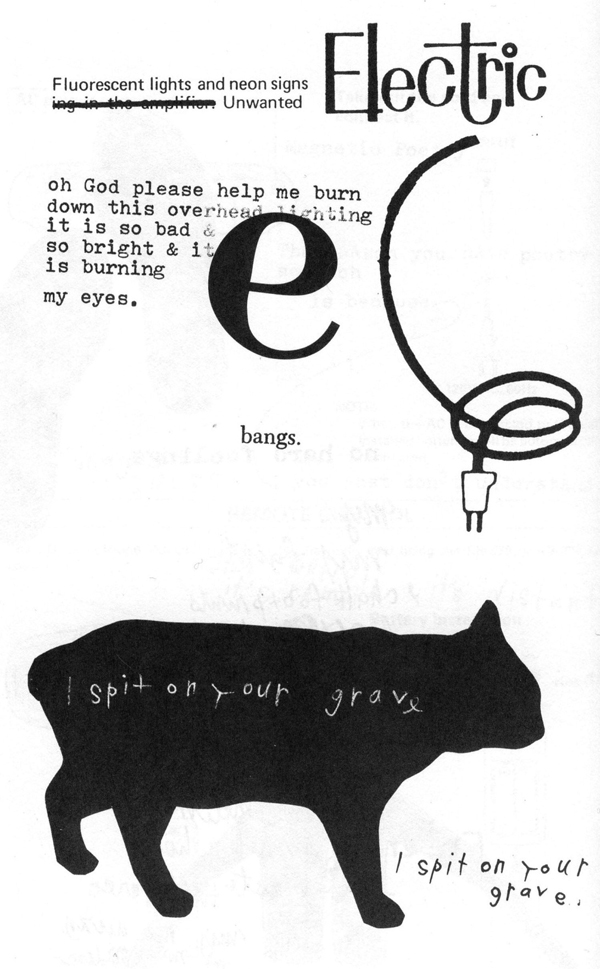【levy the eroticization of inequality summary】
Vispo
On Language
The Paris Review’s interviews have long featured single manuscript pages from among the subjects’ writings. They are meant to show the author at work, his or her method of self-editing, of revision—an illustrative supplement to the process described at length in the conversations. To me, though, they always exist first as instances of visual artistry. The particularities of each writer’s markings are immediately perceptible: the way Margaret Atwood’s handwritten lines appear impatient and vital in contrast with the prim logos of the SAS Hotel stationery on which she penned a poem; the way Yves Bonnefoy’s long, spidery insertion lines give physicality to the pallid rows of words; the way David McCullough’s xed-out typewritten phrases become so many tiny, busy intersections. In the same way, I’ve always found the looping inscriptions of Cy Twombly’s “blackboard” paintings, in particular Cold Stream, to be a kind of magic—the secret scribblings, writ large, of a mind at work. (It’s no coincidence that Twombly worked as a cryptographer in the army.)
I’m struck by the frequency, in Paris Reviewinterviews, with which authors describe writing as being a visual activity. John Edgar Wideman imagines his drafts as “palimpsests.” Don DeLillo finds that “the words typed on the white page have a sculptural quality … They match up not just through meaning but through sound and look.” Nicholson Baker admits, “I can fiddle around with something on a screen for days and think I’m getting somewhere, and it won’t be right. Then I’ll print it out and take it to bed, and instantly it’s obvious what’s bad about it, and I’ll cross out, cross out, cross out.” Words become objects, things to be looked at. I’m reminded of Apollinaire’s calligrams, Jackson Mac Low’s grid poems, and Robert Smithson’s Heap of Language(1966), which views words and phrases as “matter and not ideas.”
In poetry, such notions have long held sway: micrography, or text that forms an image, dates from ninth-century biblical codices; instances of concrete poetry exist in seventeenth-century religious poetry, and also in the early-twentieth-century works of the anarchist Futurists; asemic writing is a wordless, ideogramic form that Henri Michaux described as “interior gestures” and Roland Barthes called his “contre-écriture” (see, again, Twombly and also Jackson Pollock). Poetry that can’t simply be read or heard must be seen, experienced, enacted; how it is interpreted is the reader’s prerogative. In this way, both writing and reading are performance. In the new Winter issue, Susan Howe says, “I often think of the space of a page as a stage, with words, letters, syllable characters moving across.” In the 1960s, composer Cornelius Cardew wrote a number of indeterminate scores—stunning visual experiments—that cannot be read in any traditional way and that, like these examples of poetry, charge the performer with interpreting abstract forms and shapes that allow for an unlimited set of permutations.
Lest we think visual poetry reached its apogee as a phenomenon in the mid-twentieth century, we have The Last Vispo Anthology: Visual Poetry 1998–2008, a sampling of the current, international state of the art. For coeditors Nico Vassilakis and Crag Hill and the anthology’s wide-ranging practitioners, Vispo (a portmanteau of visual poetry) is poetry that begins on the molecular level: “It’s alphabet in every possible and available position you can imagine … The alphabet [as] a periodic table of speech elements.” And between these scripted platelets is room to shift and stir. If poetry ought to be performative, as James Fenton recommends, then it makes sense that in visual form poetry would elicit a kind of motion, an unfolding over the space of a page, and that even its sound would be voiced as a series of discoveries. Movement disrupts the continuity of a sentence, a phrase, a word. And language, unsettled, is unbound.
Pause Play Play Prev | Next
Search
Categories
Latest Posts
iPhone 15 Pro action button: What we know so far
2025-06-26 21:08Apple's iPhone 15 launch preview: What to expect
2025-06-26 20:24What It’s Like to Write About the Dead Every Day
2025-06-26 19:36Operation Rock Wallaby rains food down on wildlife hurt by bushfires
2025-06-26 18:58Popular Posts
MacBook Air reviews: 4 features critics loved, 4 they didn’t
2025-06-26 20:47The Pigshit at the End of the Rainbow: Remembering Robert Stone
2025-06-26 20:45Hinge debuts Distraction Free Dating Guide
2025-06-26 20:29Featured Posts
Best soundbar deal: Get $50 off the Amazon Fire TV Soundbar Plus
2025-06-26 20:40Apple Store is down ahead of 2023 iPhone event
2025-06-26 20:34Remember the immortal snail meme? It's on TikTok now.
2025-06-26 20:30An English Translation of Houellebecq’s "Submission" Is Coming
2025-06-26 19:53Popular Articles
Whatever Happened to R&B Groups?
2025-06-26 20:46Whatever Happened to R&B Groups?
2025-06-26 19:50On the Slaughter
2025-06-26 19:45Character AI reveals AvatarFX, a new AI video generator
2025-06-26 19:16Newsletter
Subscribe to our newsletter for the latest updates.
Comments (98521)
Wisdom Information Network
NYT Strands hints, answers for May 18
2025-06-26 20:03Sharing Information Network
Caleb Crain on Darren Aronofsky’s film Noah
2025-06-26 19:26Culture Information Network
In Berlin, an Art Scene That Money Can’t Buy—Or Can It?
2025-06-26 19:02Evergreen Information Network
The Joys of Being Thin
2025-06-26 19:01Future Information Network
Best portable power station deal: Save 44% on the Jackery Explorer 100 v2
2025-06-26 18:51